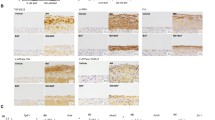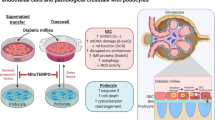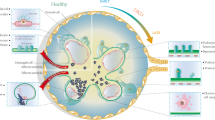Abstract
The receptor for advanced glycation end-products (RAGE), a multiligand receptor of the immunoglobulin superfamily, takes part in various inflammatory processes. The role of this receptor in the context of intercellular communication, like nanotube (NT)-mediated interaction, is largely unknown. Here, we use cell cultures of human and murine peritoneal mesothelial cells as well as murine kidneys from wild-type and RAGE knockout mouse models to assess the role of RAGE in NT formation and function. We show that loss of RAGE function results in reduced NT numbers under physiological conditions and demonstrate the involvement of MAP kinase signaling in NT formation. Additionally, we show for the first time the existence of NTs in murine kidney tissue and confirm the correlation of RAGE expression and NT numbers. Under elevated oxidative stress conditions like renal ischemia or peritoneal dialysis, we demonstrate that RAGE absence does not prevent NT formation. Rather, increased NT numbers and attenuated kidney tissue damage could be observed, indicating that, depending on the predominant conditions, RAGE affects NT formation with implications for cellular communication.





Similar content being viewed by others
References
Abounit S, Zurzolo C (2012) Wiring through tunneling nanotubes—from electrical signals to organelle transfer. J Cell Sci 125:1089–1098
Andrassy M, Volz HC, Igwe JC, Funke B, Eichberger SN, Kaya Z, Buss S, Autschbach F, Pleger ST, Lukic IK, Bea F, Hardt SE, Humpert PM, Bianchi ME, Mairbaurl H, Nawroth PP, Remppis A, Katus HA, Bierhaus A (2008) High-mobility group box-1 in ischemia-reperfusion injury of the heart. Circulation 117:3216–3226
Bierhaus A, Haslbeck KM, Humpert PM, Liliensiek B, Dehmer T, Morcos M, Sayed AA, Andrassy M, Schiekofer S, Schneider JG, Schulz JB, Heuss D, Neundorfer B, Dierl S, Huber J, Tritschler H, Schmidt AM, Schwaninger M, Haering HU, Schleicher E, Kasper M, Stern DM, Arnold B, Nawroth PP (2004) Loss of pain perception in diabetes is dependent on a receptor of the immunoglobulin superfamily. J Clin Invest 114:1741–1751
Boulanger E, Wautier MP, Wautier JL, Boval B, Panis Y, Wernert N, Danze PM, Dequiedt P (2002) AGEs bind to mesothelial cells via RAGE and stimulate VCAM-1 expression. Kidney Int 61:148–156
Caneparo L, Pantazis P, Dempsey W, Fraser SE (2011) Intercellular bridges in vertebrate gastrulation. PLoS ONE 6:e20230
Chinnery HR, Pearlman E, McMenamin PG (2008) Cutting edge: membrane nanotubes in vivo: a feature of MHC class II+ cells in the mouse cornea. J Immunol 180:5779–5783
D’Agati V, Schmidt AM (2010) RAGE and the pathogenesis of chronic kidney disease. Nat Rev Nephrol 6:352–360
Davis DM, Sowinski S (2008) Membrane nanotubes: dynamic long-distance connections between animal cells. Nat Rev Mol Cell Biol 9:431–436
Dessing MC, Pulskens WP, Teske GJ, Butter LM, van der Poll T, Yang H, Tracey KJ, Nawroth PP, Bierhaus A, Florquin S, Leemans JC (2012) RAGE does not contribute to renal injury and damage upon ischemia/reperfusion-induced injury. J Innate Immun 4:80–85
Domhan S, Ma L, Tai A, Anaya Z, Beheshti A, Zeier M, Hlatky L, Abdollahi A (2011) Intercellular communication by exchange of cytoplasmic material via tunneling nano-tube like structures in primary human renal epithelial cells. PLoS ONE 6:e21283
Eugenin EA, Gaskill PJ, Berman JW (2009) Tunneling nanotubes (TNT): a potential mechanism for intercellular HIV trafficking. Commun Integr Biol 2:243–244
Fleming TH, Humpert PM, Nawroth PP, Bierhaus A (2011) Reactive metabolites and AGE/RAGE-mediated cellular dysfunction affect the aging process: a mini-review. Gerontology 57:435–443
Gerdes HH, Carvalho RN (2008) Intercellular transfer mediated by tunneling nanotubes. Curr Opin Cell Biol 20:470–475
Hassid BG, Nair MN, Ducruet AF, Otten ML, Komotar RJ, Pinsky DJ, Schmidt AM, Yan SF, Connolly ES (2009) Neuronal RAGE expression modulates severity of injury following transient focal cerebral ischemia. J Clin Neurosci 16:302–306
Kihm LP, Wibisono D, Muller-Krebs S, Pfisterer F, Morath C, Gross ML, Morcos M, Seregin Y, Bierhaus A, Nawroth PP, Zeier M, Schwenger V (2008) RAGE expression in the human peritoneal membrane. Nephrol Dial Transplant 23:3302–3306
Koyanagi M, Brandes RP, Haendeler J, Zeiher AM, Dimmeler S (2005) Cell-to-cell connection of endothelial progenitor cells with cardiac myocytes by nanotubes: a novel mechanism for cell fate changes? Circ Res 96:1039–1041
Martinez AD, Hayrapetyan V, Moreno AP, Beyer EC (2002) Connexin43 and connexin45 form heteromeric gap junction channels in which individual components determine permeability and regulation. Circ Res 90:1100–1107
Morbini P, Villa C, Campo I, Zorzetto M, Inghilleri S, Luisetti M (2006) The receptor for advanced glycation end products and its ligands: a new inflammatory pathway in lung disease? Mod Pathol 19:1437–1445
Muhammad S, Barakat W, Stoyanov S, Murikinati S, Yang H, Tracey KJ, Bendszus M, Rossetti G, Nawroth PP, Bierhaus A, Schwaninger M (2008) The HMGB1 receptor RAGE mediates ischemic brain damage. J Neurosci 28:12023–12031
Muller-Krebs S, Kihm LP, Zeier B, Gross ML, Deppisch R, Wieslander A, Henle T, Penndorf I, Oh J, Reiser J, Nawroth PP, Zeier M, Schwenger V (2008) Renal toxicity mediated by glucose degradation products in a rat model of advanced renal failure. Eur J Clin Investig 38:296–305
Nakayama M, Kawaguchi Y, Yamada K, Hasegawa T, Takazoe K, Katoh N, Hayakawa H, Osaka N, Yamamoto H, Ogawa A, Kubo H, Shigematsu T, Sakai O, Horiuchi S (1997) Immunohistochemical detection of advanced glycosylation end-products in the peritoneum and its possible pathophysiological role in CAPD. Kidney Int 51:182–186
Onfelt B, Nedvetzki S, Yanagi K, Davis DM (2004) Cutting edge: membrane nanotubes connect immune cells. J Immunol 173:1511–1513
Pasquier J, Guerrouahen BS, Al Thawadi H, Ghiabi P, Maleki M, Abu-Kaoud N, Jacob A, Mirshahi M, Galas L, Rafii S, Le Foll F, Rafii A (2013) Preferential transfer of mitochondria from endothelial to cancer cells through tunneling nanotubes modulates chemoresistance. J Transl Med 11:94
Pyrgaki C, Trainor P, Hadjantonakis AK, Niswander L (2010) Dynamic imaging of mammalian neural tube closure. Dev Biol 344:941–947
Ramasamy R, Yan SF, Schmidt AM (2009) RAGE: therapeutic target and biomarker of the inflammatory response—the evidence mounts. J Leukoc Biol 86:505–512
Ranzinger J, Rustom A, Abel M, Leyh J, Kihm L, Witkowski M, Scheurich P, Zeier M, Schwenger V (2011) Nanotube action between human mesothelial cells reveals novel aspects of inflammatory responses. PLoS ONE 6:e29537
Rustom A, Saffrich R, Markovic I, Walther P, Gerdes HH (2004) Nanotubular highways for intercellular organelle transport. Science 303:1007–1010
Schmidt AM, Yan SD, Wautier JL, Stern D (1999) Activation of receptor for advanced glycation end products: a mechanism for chronic vascular dysfunction in diabetic vasculopathy and atherosclerosis. Circ Res 84:489–497
Schmidt AM, Yan SD, Yan SF, Stern DM (2000) The biology of the receptor for advanced glycation end products and its ligands. Biochim Biophys Acta 1498:99–111
Spees JL, Olson SD, Whitney MJ, Prockop DJ (2006) Mitochondrial transfer between cells can rescue aerobic respiration. Proc Natl Acad Sci USA 103:1283–1288
Sternberg DI, Gowda R, Mehra D, Qu W, Weinberg A, Twaddell W, Sarkar J, Wallace A, Hudson B, D’Ovidio F, Arcasoy S, Ramasamy R, D′Armiento J, Schmidt AM, Sonett JR (2008) Blockade of receptor for advanced glycation end product attenuates pulmonary reperfusion injury in mice. J Thorac Cardiovasc Surg 136:1576–1585
Sun X, Wang Y, Zhang J, Tu J, Wang XJ, Su XD, Wang L, Zhang Y (2012) Tunneling-nanotube direction determination in neurons and astrocytes. Cell Death Dis 3:e438
Tauer A, Zhang X, Schaub TP, Zimmeck T, Niwa T, Passlick-Deetjen J, Pischetsrieder M (2003) Formation of advanced glycation end products during CAPD. Am J Kidney Dis 41:S57–S60
Uchida T, Shirasawa M, Ware LB, Kojima K, Hata Y, Makita K, Mednick G, Matthay ZA, Matthay MA (2006) Receptor for advanced glycation end-products is a marker of type I cell injury in acute lung injury. Am J Respir Crit Care Med 173:1008–1015
Vallabhaneni KC, Haller H, Dumler I (2012) Vascular smooth muscle cells initiate proliferation of mesenchymal stem cells by mitochondrial transfer via tunneling nanotubes. Stem Cells Dev 21:3104–3113
von Bauer R, Oikonomou D, Sulaj A, Mohammed S, Hotz-Wagenblatt A, Grone HJ, Arnold B, Falk C, Luethje D, Erhardt A, Stern DM, Bierhaus A, Nawroth PP (2013) CD166/ALCAM mediates proinflammatory effects of S100B in delayed type hypersensitivity. J Immunol 191:369–377
Wang Y, Cui J, Sun X, Zhang Y (2011) Tunneling-nanotube development in astrocytes depends on p53 activation. Cell Death Differ 18:732–742
Watkins SC, Salter RD (2005) Functional connectivity between immune cells mediated by tunneling nanotubules. Immunity 23:309–318
Wieslander AP, Kjellstrand PT, Rippe B (1995) Heat sterilization of glucose-containing fluids for peritoneal dialysis: biological consequences of chemical alterations. Perit Dial Int 15:S52–S59, discussion S59–60
Wittig D, Wang X, Walter C, Gerdes HH, Funk RH, Roehlecke C (2012) Multi-level communication of human retinal pigment epithelial cells via tunneling nanotubes. PLoS ONE 7:e33195
Wittkowski H, Foell D, af Klint E, De Rycke L, De Keyser F, Frosch M, Ulfgren AK, Roth J (2007) Effects of intra-articular corticosteroids and anti-TNF therapy on neutrophil activation in rheumatoid arthritis. Ann Rheum Dis 66:1020–1025
Xie J, Mendez JD, Mendez-Valenzuela V, Aguilar-Hernandez MM (2013) Cellular signalling of the receptor for advanced glycation end products (RAGE). Cell Signal 25:2185–2197
Zeng S, Feirt N, Goldstein M, Guarrera J, Ippagunta N, Ekong U, Dun H, Lu Y, Qu W, Schmidt AM, Emond JC (2004) Blockade of receptor for advanced glycation end product (RAGE) attenuates ischemia and reperfusion injury to the liver in mice. Hepatology 39:422–432
Zhu D, Tan KS, Zhang X, Sun AY, Sun GY, Lee JC (2005) Hydrogen peroxide alters membrane and cytoskeleton properties and increases intercellular connections in astrocytes. J Cell Sci 118:3695–3703
Acknowledgments
We wish to thank Dr. Luis Becker and Simone Schmidt, both from the Department of Nephrology, as well as Annette Kohl from the Department of Orthodontics and Dentofacial Orthopaedics at the University of Heidelberg for technical assistance. Additional thanks goes to Dr. Arianeb Mehrabi from the Department of Surgery as well as to the Nikon Imaging Center, both at the University of Heidelberg, Germany.
Author information
Authors and Affiliations
Corresponding author
Electronic supplementary material
Below is the link to the electronic supplementary material.
Supplementary Fig. 1
Characterization of patient-derived HPMCs. Brightfield and immunofluorescence microscopy of HPMCs isolated from portions of omentum from seven different donors. Cells were characterized by their cellular morphology (left panel) as well as by the expression of the mesothelial cell marker Cytokeratin 18 (central panel) and the fibroblast cell marker FSP (right panel). Cell nuclei were stained with Hoechst 33342. (GIF 458 kb)
Supplementary Fig. 2
Characterization of additive patient-derived HPMCs. Brightfield and immunofluorescence microscopy of HPMCs isolated from portions of omentum from three different donors. Cells were characterized by their cellular morphology (left panel) as well as by the expression of the mesothelial cell marker Cytokeratin 18, the fibroblast cell marker FSP and the mesenchymal cell marker Vimentin. Cell nuclei were stained with Hoechst 33342. (GIF 281 kb)
Supplementary Fig. 3
NT-formation between HPMCs is dependent on p38 activation. HPMCs were treated with proteasome inhibitor 1 h prior to stimulation with MG alone or in combination with a RAGE-blocking antibody (a, b). After 1 h of stimulation, cells were lysed and p-p38 (a, b) as well as total p38 protein expression (c, d) was assessed by western blot (e, f). For the investigation of NT numbers, HPMCs were treated with a p38 MAPK inhibitor (black bars) or left untreated (white bars) and NT numbers were analyzed 1 h after cell plating. Data are shown as means ± SEM, n = 3 for each donor. (GIF 69 kb)
Supplementary Fig. 4
Detection of apoptosis and necrosis in HPMCs after treatment with dialysis solution and TNX/CHX. Brightfield and immunofluorescence microscopy of HPMCs from Donor VIII (a), IX (b) and X (c) stained with FITC-Annexin V, Ethidium homodimer-III and Hoechst 33342 cultured in medium (upper panel), 1 h after incubation with dialysis solution (middle panel) and 6 h after treatment with TNF/CHX (lower panel). The graphs in (d) show that treatment of the cells with dialysis solution has no effect on apoptosis (upper graph) or necrosis (lower graph) compared to TNF/CHX treatment. (GIF 517 kb)
Rights and permissions
About this article
Cite this article
Ranzinger, J., Rustom, A., Heide, D. et al. The receptor for advanced glycation end-products (RAGE) plays a key role in the formation of nanotubes (NTs) between peritoneal mesothelial cells and in murine kidneys. Cell Tissue Res 357, 667–679 (2014). https://doi.org/10.1007/s00441-014-1904-y
Received:
Accepted:
Published:
Issue Date:
DOI: https://doi.org/10.1007/s00441-014-1904-y




